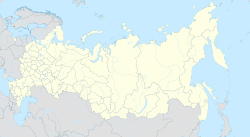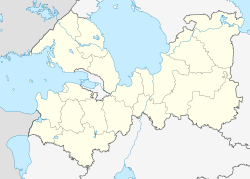world.wikisort.org - Russia
Luga (Russian: Лу́га; Finnish: Ylä-Laukaa or Laukaa; Votic: Laugaz; Estonian: Luuga) is a town and the administrative center of Luzhsky District in Leningrad Oblast, Russia, located on the Luga River 140 kilometers (87 mi) south of St. Petersburg. Population: 38,593 (2010 Census);[3] 40,434 (2002 Census);[8] 41,769 (1989 Census).[9]
Luga
Луга | |
|---|---|
Town[1] | |
 Luga in 2003 | |
 Flag  Coat of arms | |
Location of Luga  | |
 Luga Location of Luga  Luga Luga (Leningrad Oblast) | |
| Coordinates: 58°44′N 29°49′E | |
| Country | Russia |
| Federal subject | Leningrad Oblast[1] |
| Administrative district | Luzhsky District[1] |
| Settlement municipal formation | Luzhskoye Settlement Municipal Formation[1] |
| Founded | August 3 (14), 1777[2] |
| Town status since | August 3 (14), 1777[2] |
| Elevation | 48 m (157 ft) |
| Population | |
| • Total | 38,593 |
| • Estimate (2018)[4] | 35,262 (−8.6%) |
Administrative status | |
| • Capital of | Luzhsky District[1], Luzhskoye Settlement Municipal Formation[1] |
Municipal status | |
| • Municipal district | Luzhsky Municipal District[5] |
| • Urban settlement | Luzhskoye Urban Settlement[5] |
| • Capital of | Luzhsky Municipal District[5], Luzhskoye Urban Settlement[5] |
| Time zone | UTC+3 (MSK |
| Postal code(s)[7] | 188230-188233, 188235-188238, 188229, 188299 |
| Dialing code(s) | +7 81372 |
| OKTMO ID | 41633101001 |
History
It was founded on the banks of the river of that name by order of the Catherine the Great on August 3 (14), 1777.[2] The town developed in following stages:
- Initial construction (1777–c. 1800)
- Early growth to population of 3,000 (c. 1810–c. 1860)
- Intense social and urban development (c. 1870–1910)
- Soviet development according to the typical plan for smaller towns (1926–c. 1950)
- Reconstruction of the historical town structure (c. 1960–c. 1995)
- Transition to free market agro-industrial town (c. 1995–2005)
Luga was founded as a town in Pskov Viceroyalty, but in March 3 (14), 1782 it was transferred to St. Petersburg Governorate[2] (renamed Petrogradsky in 1913 and Leningradsky in 1924) and became the seat of Luzhsky Uyezd. In 1918, important events of the Russian Civil War took place in the area, when the White Army unsuccessfully tried to conquer Petrograd.[2]
On August 1, 1927, the uyezds were abolished and Luzhsky District, with the administrative center in Luga, was established.[10] The governorates were also abolished and the district became a part of Luga Okrug of Leningrad Oblast.[11] On July 23, 1930, the okrugs were abolished as well and the districts were directly subordinated to the oblast. On September 19, 1939, Luga became a town of oblast significance and was thus no longer a part of the district.[11]
The World War II German advance on Leningrad was temporarily halted by seven regular, militia, and irregular divisions in the Luga area and this delayed the commencement of the Siege of Leningrad by over a month.[12] In recognition of this feat, the town was awarded the title of "Hero City" and listed as one of the World War II Cities of Military Glory by Vladimir Putin, the President of Russia.[citation needed] German occupation of Luga lasted from August 24, 1941 to February 12, 1944.[citation needed]
In 2010, the administrative structure of Leningrad Oblast was harmonized with its municipal structure[13] and Luga became a town of district significance.
Administrative and municipal status
Within the framework of administrative divisions, Luga serves as the administrative center of Luzhsky District.[1] As an administrative division, it is, together with four rural localities, incorporated within Luzhsky District as Luzhskoye Settlement Municipal Formation.[1] As a municipal division, Luzhskoye Settlement Municipal Formation is incorporated within Luzhsky Municipal District as Luzhskoye Urban Settlement.[5]
Economy
Industry

There are enterprises of construction, chemical, and food industries in Luga.[14]
Transportation
Luga lies on the railway line connecting the Baltiysky railway station of St. Petersburg with Pskov. Another railway line to Batetsky and Veliky Novgorod branches off east. Both have suburban service.
The M20 Highway, connecting St. Petersburg with Pskov and eventually with Kyiv, passes Luga. In Luga, two more roads branch eastwards: one running to Veliky Novgorod and another one to Lyuban and Mga, largely following the border of Leningrad Oblast.
Education
The town has a university (KGU Kirilla and Mefodiya), three Institutes of Technical Education, and six schools.
Military
Luga is home to the 26th Missile Brigade.[15]
Culture and recreation

Luga contains twenty-five objects classified as cultural and historical heritage of local significance.[16] These include the main sights remaining from the 18th and the 19th century such as the St. Catherine Cathedral (1786) and the Resurrection Cathedral (1872—1877).
The Luzhsky District Museum, the only state museum in the district, is located in Luga.[17]
Twin towns and sister cities
Luga is twinned with:
Notable people
- Anton Zaltsa (1843-1916) - general
- Walter Polakov (1879-1948) - mechanical engineer
- Gratsian Botev (1928-1981) - sprint canoer
- Nina Urgant (1929-2021) - film and stage actress
- Boris Marshak (1933-2006) - archeologist
- Gennadi Nilov (1936) - actor
- Lyudmila Besrukova (1945) - sprint canoer
- Georgi Zažitski (1949) - fencer
- Vladimir Bystrov (1984) - footballer
References
Notes
- Oblast Law #32-oz
- История Лужского района и города Луга (in Russian). Официальный сайт администрации Лужского муниципального района. Retrieved March 10, 2014.
- Russian Federal State Statistics Service (2011). Всероссийская перепись населения 2010 года. Том 1 [2010 All-Russian Population Census, vol. 1]. Всероссийская перепись населения 2010 года [2010 All-Russia Population Census] (in Russian). Federal State Statistics Service.
- "26. Численность постоянного населения Российской Федерации по муниципальным образованиям на 1 января 2018 года". Federal State Statistics Service. Retrieved January 23, 2019.
- Law #65-oz
- "Об исчислении времени". Официальный интернет-портал правовой информации (in Russian). June 3, 2011. Retrieved January 19, 2019.
- Почта России. Информационно-вычислительный центр ОАСУ РПО. (Russian Post). Поиск объектов почтовой связи (Postal Objects Search) (in Russian)
- Russian Federal State Statistics Service (May 21, 2004). Численность населения России, субъектов Российской Федерации в составе федеральных округов, районов, городских поселений, сельских населённых пунктов – районных центров и сельских населённых пунктов с населением 3 тысячи и более человек [Population of Russia, Its Federal Districts, Federal Subjects, Districts, Urban Localities, Rural Localities—Administrative Centers, and Rural Localities with Population of Over 3,000] (XLS). Всероссийская перепись населения 2002 года [All-Russia Population Census of 2002] (in Russian).
- Всесоюзная перепись населения 1989 г. Численность наличного населения союзных и автономных республик, автономных областей и округов, краёв, областей, районов, городских поселений и сёл-райцентров [All Union Population Census of 1989: Present Population of Union and Autonomous Republics, Autonomous Oblasts and Okrugs, Krais, Oblasts, Districts, Urban Settlements, and Villages Serving as District Administrative Centers]. Всесоюзная перепись населения 1989 года [All-Union Population Census of 1989] (in Russian). Институт демографии Национального исследовательского университета: Высшая школа экономики [Institute of Demography at the National Research University: Higher School of Economics]. 1989 – via Demoscope Weekly.
- Лужский уезд (1917 - август 1927 г.) (in Russian). Система классификаторов исполнительных органов государственной власти Санкт-Петербурга. Archived from the original on March 11, 2014. Retrieved March 11, 2014.
- Лужский район (август 1927 г.) (in Russian). Система классификаторов исполнительных органов государственной власти Санкт-Петербурга. Archived from the original on March 10, 2014. Retrieved March 10, 2014.
- Clark, Alan (2005). Barbarossa: The Russian - German Conflict 1941-1945. London: Cassell. p. 114. ISBN 978-0-304-35864-9.
- Отчет о работе комитета по взаимодействию с органами местного самоуправления Ленинградской области в 2010 году (in Russian). Комитет по печати и связям с общественностью Ленинградской области. Retrieved March 5, 2014.
- Промышленность (in Russian). Официальный сайт администрации Лужского муниципального района. Retrieved February 22, 2013.
- Kristensen, Hans M.; Korda, Matt (2021). "Russian nuclear weapons, 2021". Bulletin of the Atomic Scientists. 77 (2): 90–108. doi:10.1080/00963402.2021.1885869. ISSN 0096-3402.
This could indicate the 9M729 has been added to a fifth brigade: the 26th Missile Brigade outside Luga about 125 km south of St. Petersburg.
- Памятники истории и культуры народов Российской Федерации (in Russian). Russian Ministry of Culture. Retrieved June 2, 2016.
- Лужский краеведческий музей (in Russian). Российская сеть культурного наследия. Retrieved February 19, 2013.
- "Ystävyyskaupungit ja -kunnat". mikkeli.fi. Archived from the original on April 29, 2014. Retrieved April 28, 2014.
Sources
- Законодательное собрание Ленинградской области. Областной закон №32-оз от 15 июня 2010 г. «Об административно-территориальном устройстве Ленинградской области и порядке его изменения», в ред. Областного закона №23-оз от 8 мая 2014 г. «Об объединении муниципальных образований "Приморское городское поселение" Выборгского района Ленинградской области и "Глебычевское сельское поселение" Выборгского района Ленинградской области и о внесении изменений в отдельные Областные законы». Вступил в силу со дня официального опубликования. Опубликован: "Вести", №112, 23 июня 2010 г. (Legislative Assembly of Leningrad Oblast. Oblast Law #32-oz of June 15, 2010 On the Administrative-Territorial Structure of Leningrad Oblast and on the Procedures for Its Change, as amended by the Oblast Law #23-oz of May 8, 2014 On Merging the Municipal Formations of "Primorskoye Urban Settlement" in Vyborgsky District of Leningrad Oblast and "Glebychevskoye Rural Settlement" in Vyborgsky District of Leningrad Oblast and on Amending Various Oblast Laws. Effective as of the day of the official publication.).
- Законодательное собрание Ленинградской области. Областной закон №65-оз от 28 сентября 2004 г. «Об установлении границ и наделении соответствующим статусом муниципального образования Лужский муниципальный район и муниципальных образований в его составе», в ред. Областного закона №17-оз от 6 мая 2010 г «О внесении изменений в некоторые областные законы в связи с принятием федерального закона "О внесении изменений в отдельные законодательные акты Российской Федерации в связи с совершенствованием организации местного самоуправления"». Вступил в силу через 10 дней со дня официального опубликования (1 ноября 2004 г.). Опубликован: "Вестник Правительства Ленинградской области", №31, 22 октября 2004 г. (Legislative Assembly of Leningrad Oblast. Oblast Law #65-oz of September 28, 2004 On Establishing the Borders of and Granting an Appropriate Status to the Municipal Formation of Luzhsky Municipal District and to the Municipal Formations Comprised By It, as amended by the Oblast Law #17-oz of May 6, 2010 On Amending Article 2 of the Oblast Law "On Establishing the Borders of and Granting an Appropriate Status to the Municipal Formation of Lodeynopolsky Municipal District and to the Municipal Formations Comprised By It". Effective as of after 10 days from the day of the official publication (November 1 2004).).
На других языках
[de] Luga (Leningrad)
Luga (russisch Лу́га) ist eine Stadt in der Oblast Leningrad in Russland.- [en] Luga, Leningrad Oblast
[es] Luga
Luga (en ruso: Луга; Finés: Laukaa; Votico: Laugaz) es una ciudad de la óblast de Leningrado, en Rusia. Centro administrativo del raión de Luga. Está ubicada a orillas del río Luga, 140 km al sur de San Petersburgo. Cuenta con una población de 38.106 habitantes (Censo de 2010).[ru] Луга
Лу́га — город (с 1777 года) в России на одноимённой реке; административный центр Лужского городского поселения и Лужского муниципального района Ленинградской области, город воинской славы России (с мая 2008 года).Другой контент может иметь иную лицензию. Перед использованием материалов сайта WikiSort.org внимательно изучите правила лицензирования конкретных элементов наполнения сайта.
WikiSort.org - проект по пересортировке и дополнению контента Википедии